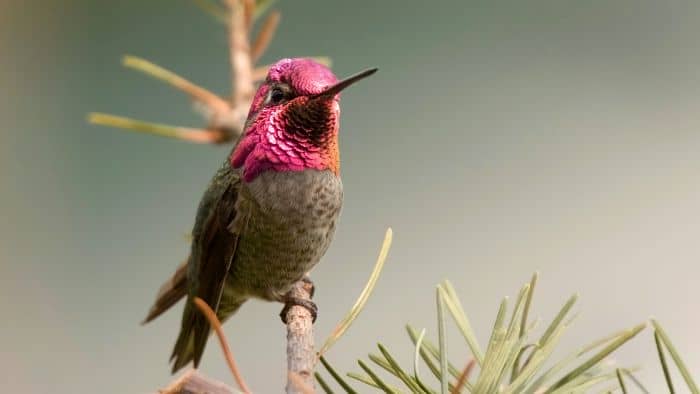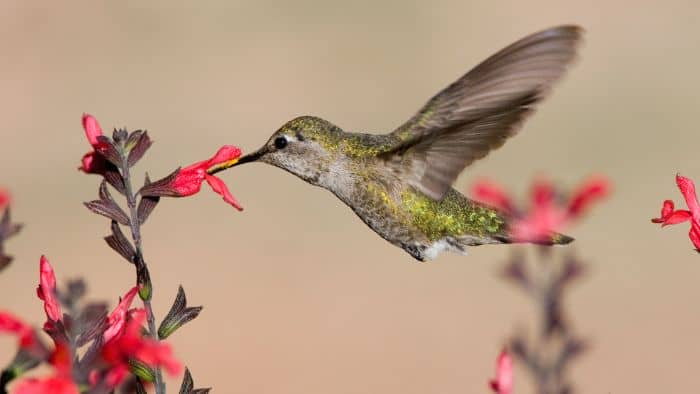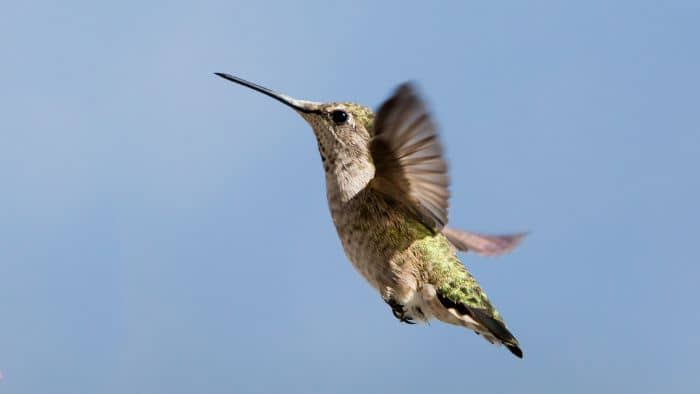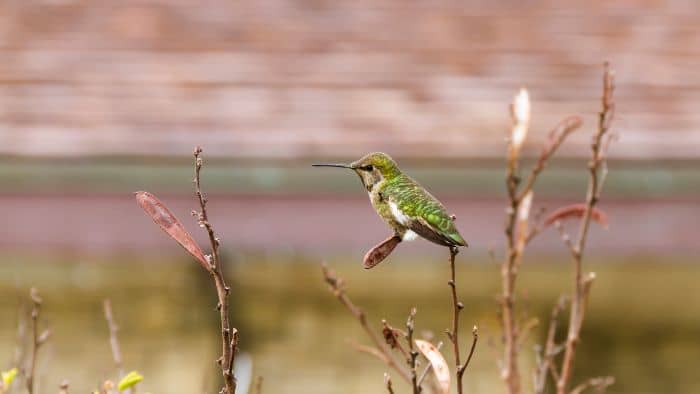If you’ve ever wondered about the differences between the Male and Female Anna’s Hummingbirds, then this blog post is aimed at you. These medium-sized creatures belong to the Trochilidae family of birds which are indigenous to western North American coastal regions. This species has also increased its breeding range substantially.
This is because of the transplantation of exotic decorative plants into residential areas along the Pacific coast and in inland deserts which offers more nectar and nesting locations. An example of ecological release that depends on tolerance to colder winter temperatures, imported plants, and a supply of nectar feeders during winter is Anna’s hummingbirds’ year-round habitation.
These birds use an extended tongue to consume floral nectar. They eat tiny insects and other arthropods that they catch in the air or that they collect from vegetation. Let’s have a look below to find out more about the male vs female Anna’s hummingbird species.
Anna’s Hummingbird Male Vs Female
When it comes to male and female Anna’s hummingbirds, the wingspan of these creatures is about 12 cm. These birds range in size from 3.9 to 4.3 inches and weigh between 2.8 to 5.7 g. Their flanks are green and their back is an iridescent bronze-green with a pale grey belly and chest and have long, erect, and slender bills.
They can often be observed in parks and backyards, where they frequent bird feeders and floral plants. Listed below are a few key features of these gorgeous birds.

Male Anna’s Hummingbirds:
- The adult male has a dark, forked tail and an iridescent crimson-red crown and gorget, which can seem dull in the absence of direct sunlight.
- The only hummingbird species in North America with a red crown is the male Anna’s hummingbird.
- Large stacks of melanosomes in the feather barbules that are organized as layers and separated by keratin are what cause iridescence in male hummingbird crowns.
- The iridescence, which changes the head and gorget colors with the changing angle of light, is made possible by the barbules, which reflect incident light.
- This coloration advantage is used for courtship attractiveness and territory defense.
- Male birds with higher protein intake have more vibrant crowns and higher degrees of iridescence in their head feathers.
- The male calls in trees and bushes with a metallic, scratchy tone.
Female Anna’s Hummingbirds:
- The females are smaller and less spectacular than the males and have iridescent red gorgets.
- Females have a dull green crown, grey chest and belly, and a black, rounded tail with white tips on the outer feathers. The throat may or may not have some red iridescence.
- Without the male’s help, the female is responsible for raising the young.
- The female bird makes a nest in a bush, tree, vine, or on wires or other man-made surfaces.
- The female uses downy feathers, animal hair, and plant fibers to make the nest. Its exterior is covered in lichen chips, plant debris, and sporadic urban trash like paint chips and paper.
- Spider silk is used to stitch together the nest’s components.
- Depending on the region and the climate, they have been found to nest as early as mid-
- December and as late as June.

Getting to Know the Male Anna Hummingbird
The male Anna’s hummingbird sings during courting. This is unlike the behavior of the majority of northern temperate hummingbirds who do not. The tune lasts for more than 10 seconds and is thin and squeaky with buzzes and chirps in between. Males have been seen diving in the air over their territories during the breeding season.
The male bird will also rise to a height of around 40 meters when a female flies onto his territory before diving over her. This species reaches an average speed of 27 m/s per second as it nears the bottom of the dive. Some have referred to the male’s audible as an explosion of squeals made by the tail feathers as it descends toward the bottom of the dive.
Hybridization between male and female Anna’s hummingbirds and other species happens regularly, especially with the congeneric Costa’s hummingbird. It has been thought that these natural hybrids are new species. A good example will be the violet-throated hummingbird which is a hybrid of a black-chinned hummingbird and Anna’s hummingbird. Here’s a great video about this dainty bird species.
Identifying Annas Hummingbird Female
Although the male and female Anna’s hummingbirds look similar, the female lacks the large iridescent gorget and head feathers of the male. This is because the female’s backs are covered with shiny green feathers that reach their crowns and nape. The majority of their underparts are a light gray tint, however, their throats do include a few scarlet feathers.
In addition to morphological variations, female Anna’s hummingbirds differ from males in the following ways:
- Males are far more aggressive and visible than females.
- The female Anna’s hummingbird does not sing.
- The females are in charge of constructing the nest, caring for the eggs, and raising the chicks.
- The gorget and color on the face and head of the female are not as developed as those of the males, but they share the males’ metallic green back.
- Though not as many as adult males, they do have little violet-colored feathers on their throats.
- However, don’t mistake female Anna’s hummingbirds for immature males as both have similar levels of pigment behind the throat, metallic green upperparts, and greyish underparts.
- On average, the females’ bills and wings are a little bit longer. It is a black, straight, thin bill that is around the length of her head.
- This bird also has black feet and very short legs, the same as other hummingbirds.

Behavior of Male and Female Anna’s Hummingbirds
If you’re a bird watcher, then distinguishing behaviors between the male and female Anna’s hummingbirds would be beneficial in identifying them or telling them apart. The female has more modest colors, fewer vocalizations, and less aggression and display activity, making them far less noticeable than males. Listed below are a few behavioral patterns that you should take note of.
A Distinction of Hummingbird Behavioral Patterns:
- Male Anna’s hummingbirds put on a spectacular display when in flight. This is to catch the attention of the females and keep them enthralled.
- Females will enter a male’s breeding territory in order to trigger this display and find a potential partner.
- While females are more interested in protecting nesting territory, males will defend food sources and breeding areas.
- A common illustration of a feeding territory is a flowering plant or a hummingbird feeder in the backyard.
- Some females will protect their feeding grounds as well, although usually only before laying their eggs.
- Male Anna’s hummingbirds are renowned for their memorized songs.
- Females do make a few calls using basic notes. Both a lengthier chattering call and a longer twittering call can be heard from the female.
- These sounds are typically heard during conflicts or other times when she is upset.

Conclusion
Contrary to other hummingbird species in their region, Anna’s hummingbirds often lay their eggs in the winter. These birds are able to escape competing with others of their kind for nesting and feeding supplies by breeding during the winter. When it comes to male and female Anna’s hummingbirds, the female species may care for their young without the male’s assistance.
She is an excellent mother, choosing the location of the nest, constructing the nest, incubating the eggs, and caring for the young hummingbirds all by herself. Additionally, when it comes to migration, they have a few little tricks up their sleeves. These incredibly small birds set records in a variety of categories, including how quickly they move.
The daytime weight gain of Anna’s hummingbirds in cold weather is caused by the birds’ conversion of sugar to fat. However, with insufficient amounts of body fat or plumage, they can endure cold spells by slowing down their metabolism and going into torpor which is a state of extended sleep. Here’s a link with more information about Anna’s hummingbirds.

